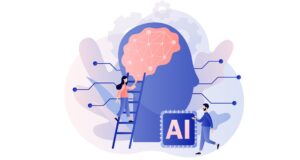AI in Journalism
AI in Journalism: examples and relevant tools
The world of journalism has always been a dynamic one, constantly evolving to keep up with the changing ways people consume information.
In recent years, Artificial Intelligence (AI) has become a powerful tool, reshaping how news is gathered, reported, and shared. From spotting breaking news on social media to automating reports and even tailoring content to individual readers, AI is proving to be a game-changer for the industry.
At its core, AI in journalism uses advanced technologies like machine learning and natural language processing (NLP) to handle tasks that were previously time-consuming or beyond human capability. These include data analysis, fact-checking, creating content, and engaging with audiences in personalised ways.
But while the possibilities are exciting, they come with challenges. Concerns about bias, transparency, and the authenticity of AI-generated content must be carefully addressed. In this article, we’ll explore how AI is shaping journalism, the benefits it offers, the risks it poses, and what the future might hold.
The Evolution of AI in Journalism
Historical Context: Automation Before AI
The journey toward AI in journalism began with early automation tools. Software like Wordsmith, developed by Automated Insights, was used to automate repetitive writing tasks such as generating sports scores or financial summaries. These tools relied on structured data to produce formulaic reports efficiently.
Advancements to AI: The Role of NLP and Machine Learning
The leap from simple automation to AI became possible with advancements in NLP and machine learning. Tools such as OpenAI’s GPT models and Google’s BERT have allowed computers to not only generate human-like text but also comprehend language nuances and adapt content to different audiences. This shift has transformed AI from a tool for routine tasks to a partner in creating and enhancing journalism.
Applications of AI in Journalism

1. News Gathering: Faster, Smarter, Real-Time
AI helps journalists monitor vast amounts of data to identify newsworthy events. Social media, public datasets, and open-source platforms are mined in real time to detect breaking stories and trending topics.
- Example: Reuters uses News Tracer to track breaking stories on Twitter, filtering out noise to highlight credible news.
- Key Tools:
- Dataminr: Alerts journalists to breaking news by analysing social media and public data.
- News Tracer: Evaluates tweets for relevance and reliability.
2. Content Creation: Automated and Human-Like Writing
AI assists in generating both structured reports and creative content, saving journalists time for investigative or in-depth pieces.
- Example: The Associated Press (AP) employs Wordsmith to automate reports on quarterly earnings, reducing turnaround time.
- Key Tools:
3. Personalisation and Audience Engagement: Connecting More Effectively
AI enhances how news platforms deliver content to readers, making it more personalised and engaging. Algorithms analyse user behaviour to recommend stories or adapt delivery methods to individual preferences.
- Example: The BBC uses AI-driven tools to recommend personalised content based on viewer behaviour.
- Key Tools:
4. Fact-Checking and Combating Misinformation: Maintaining Credibility
AI has become indispensable in the fight against misinformation, enabling real-time fact-checking and identification of false claims.
- Example: Full Fact employs AI to identify inaccuracies in statements and articles, providing corrections promptly.
- Key Tools:
- ClaimBuster: Flags questionable statements in speeches and news articles.
- Full Fact: Uses algorithms to detect and analyse claims for factual accuracy.
Benefits of AI in Journalism
- Increased Efficiency: AI tools automate laborious tasks like data collation and report generation, freeing up journalists for creative and investigative work.
- Improved Accuracy: AI-powered fact-checking reduces human error and helps combat misinformation.
- Enhanced Storytelling: Interactive formats like infographics and VR experiences are now possible with AI.
- Scalability: AI enables the production of hyper-localised or niche content at scale, reaching specific audiences effectively.
Challenges and Ethical Concerns
Bias in AI Algorithms
AI systems can inherit biases from the datasets they are trained on, potentially perpetuating stereotypes or inaccuracies. For instance, facial recognition tools have faced criticism for racial bias due to biased training data.Job Displacement
The automation of tasks like report writing raises fears about the displacement of human journalists, particularly in entry-level or routine roles.Transparency and Authenticity
Audiences may feel deceived if AI-generated content is not clearly labelled. Transparency is essential to maintaining trust.Loss of Human Touch
Over-reliance on AI risks reducing the depth and empathy that human journalists bring to storytelling.
Future of AI in Journalism
Collaborative AI
AI is unlikely to replace journalists entirely. Instead, tools like Grammarly and Hemingway Editor will support journalists by refining language, improving readability, and assisting with research.Deepfake Detection and Advanced Fact-Checking
Emerging tools will focus on identifying manipulated media, such as deepfakes, and detecting misinformation with greater nuance.Immersive Journalism
AI-driven innovations will enable interactive and immersive experiences, such as virtual reality (VR) storytelling or real-time data visualisations.
Case Studies
The Washington Post’s Heliograf
Heliograf generates thousands of short stories on topics like sports and elections, offering timely updates and freeing up staff for investigative reporting.
Bloomberg’s Cyborg
Bloomberg’s Cyborg analyses financial data and creates articles at scale, enabling journalists to focus on deeper analysis.
Key Tools for AI in Journalism
- NLP Tools: OpenAI, Google BERT, Hugging Face.
- Automation Tools: Wordsmith, Heliograf.
- Audience Engagement: Chartbeat, Persado.
- Fact-Checking: Full Fact, ClaimBuster.
Conclusion
AI is not just a tool but a transformative force in journalism. While it enhances efficiency, accuracy, and storytelling, ethical concerns such as bias, transparency, and authenticity must be carefully managed.
As AI evolves, collaboration between human journalists and AI systems will be crucial to maintaining the trust, creativity, and integrity of journalism.
FAQ Section
1. What is AI’s role in journalism?
AI automates repetitive tasks, enhances content creation, and improves audience engagement while maintaining accuracy through advanced fact-checking.
2. Will AI replace journalists?
No, AI is expected to augment rather than replace journalists, handling routine tasks to allow for greater focus on investigative and creative work.
3. What are the risks of using AI in journalism?
Risks include bias in algorithms, potential job displacement, lack of transparency in AI-generated content, and the erosion of human elements in storytelling.
4. How can AI combat misinformation?
AI tools like Full Fact and ClaimBuster analyse claims, verify facts, and flag misinformation in real time.
5. What skills should journalists develop to adapt to AI?
Journalists should focus on data literacy, investigative techniques, ethical decision-making, and creative storytelling to complement AI capabilities.




















